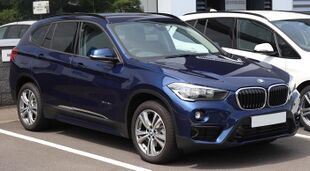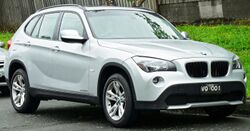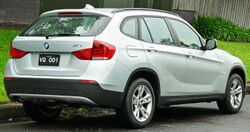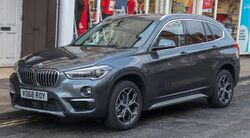BMW X1
Topic: Engineering
 From HandWiki - Reading time: 4 min
From HandWiki - Reading time: 4 min
| BMW X1 | |
|---|---|
 | |
| Overview | |
| Manufacturer | BMW |
| Production | 2009–present |
| Body and chassis | |
| Class | Subcompact luxury SUV |
| Body style | 5-door SUV |
| Layout |
|
The BMW X1 is a line of subcompact luxury SUV produced by BMW. Debuted in 2009, the first-generation X1 has been based on the E90 3 Series and offers rear-wheel drive layout as standard. At its introduction, it was positioned as the smallest SUV in BMW line-up below the X3, aiming a wider range of customers due to its smaller size, increased efficiency, and a lower price tag due to the all-wheel drive layout (xDrive) being optional.
The second-generation X1 marked the switch to the front-wheel drive-based layout by using the UKL2 platform shared with the BMW 2 Series Active Tourer and the Mini Countryman.[1] Despite its name, it is currently only the second smallest SUV produced by BMW since the introduction of the X2.[2]
First generation (E84; 2009)
The E84 X1 is the first-generation model and was originally presented as the BMW Concept X1 at the Paris Motor Show in 2008.[3] Development of the vehicle started in 2006 when BMW identified the need for a smaller and more efficient model in its SUV line-up as petrol prices were increasing. Due to the urgent need to produce the vehicle, development and pre-production time was shortened by 40 percent compared to previous X Series models.[4][5]
It is based on the same platform as the E90 3 Series[6] and features the same 2,760 mm (109 in) wheelbase. The X1 is the first BMW X Series to be available in the sDrive trim (two-wheel drive). It was not introduced to the United States until 2012.[7]
In 2013, the E84 X1 underwent a facelift, featuring restyled exterior and interior design elements, as well as the integration of BMW EfficientDynamics on all models.[8] The original X1 sold 820,529 units.
Second generation (F48; 2015)
The F48 X1 is the second- and current-generation model. It is built upon the front-wheel drive based UKL2 platform,[9] and is available in long-wheelbase and long-wheelbase hybrid variants in China.[10] The range consists of turbocharged 3-cylinder and 4-cylinder petrol and diesel engine options.[11] Base models are front-wheel drive (branded as sDrive), with all-wheel drive (xDrive) available as an option and is standard for some higher-end models.[12]
Production and sales
The following are the production and sales figures for BMW X1 models:
| Year | Production | Sales | ||
|---|---|---|---|---|
| Europe[13] | U.S.[14] | China[15] | ||
| 2009 | 8,499[16] | 8,925 | ||
| 2010 | 99,990[17] | 77,706 | ||
| 2011 | 126,429[18] | 83,086 | ||
| 2012 | 147,776[19] | 65,254 | 8,947 | 18,798 |
| 2013 | 161,353[20] | 64,313 | 26,512 | 22,913 |
| 2014 | 156,471[21] | 61,797 | 22,808 | 46,563 |
| 2015 | 120,011[22] | 42,107 | 14,420 | 41,200 |
| 2016 | 220,378[23] | 95,380 | 27,812 | 54,900 |
| 2017 | 286,743[24] | 118,051 | 30,826 | 90,574 |
| 2018 | 286,827[25] | 111,496 | 29,060 | 97,215 |
| 2019 | 266,124[26] | 108,507 | 17,815 | 97,364 |
| 2020 | 230,041[27] | 88,486 | 14,405 | 95,096 |
References
- ↑ "BMW X1" (in en). 2018-02-14. https://www.topgear.com/car-reviews/bmw/x1-0.
- ↑ "X factor: prices and on-sale date of BMW's X2 small SUV" (in en-GB). 2017-10-27. https://www.driving.co.uk/news/x-factor-prices-sale-date-bmws-x2-small-suv/.
- ↑ "Paris 2008: BMW X1 concept" (in en). Autoblog. http://www.autoblog.com/2008/10/02/paris-2008-bmw-x1-concept/.
- ↑ Hemmes, Henny (2009-10-02). "First Drive: 2010 BMW X1 xDrive 20d" (in en-US). https://www.thedetroitbureau.com/2009/10/first-drive-2010-bmw-x1-xdrive-20d/.
- ↑ https://www.wapcar.my/cars/bmw/x1
- ↑ "BMW X1 SUV (2010-2015)" (in en). Carbuyer. http://www.carbuyer.co.uk/reviews/bmw/x1/hatchback-2010-2015/review.
- ↑ "2013 BMW X1 will debut at New York Auto Show" (in en-US). BMW BLOG. 2012-03-16. http://www.bmwblog.com/2012/03/16/2013-bmw-x1-will-debut-at-new-york-auto-show/.
- ↑ "BMW X1 (2009 - 2012) used car review | Car review | RAC Drive" (in en). https://www.rac.co.uk/drive/car-reviews/bmw/x1/210203/.
- ↑ "2016 BMW X1 xDrive28i Test | Review | Car and Driver" (in en). Car and Driver. https://www.caranddriver.com/reviews/2016-bmw-x1-xdrive28i-test-review.
- ↑ "Extra space, extra X-ness. The new BMW X1 Long Wheelbase." (in en). https://www.press.bmwgroup.com/global/article/detail/T0259383EN/extra-space-extra-x-ness-the-new-bmw-x1-long-wheelbase.
- ↑ "BMW X1 Reviews | BMW X1 Price, Photos, and Specs | Car and Driver" (in en). Car and Driver. https://www.caranddriver.com/bmw/x1.
- ↑ "BMW X1 review 2018 | What Car?" (in en). What Car?. https://www.whatcar.com/bmw/x1/estate/review/.
- ↑ "BMW X1 European sales figures" (in en-US). carsalesbase.com. http://carsalesbase.com/european-car-sales-data/bmw/bmw-x1/.
- ↑ "BMW X1 US car sales figures" (in en-US). carsalesbase.com. http://carsalesbase.com/us-car-sales-data/bmw/bmw-x1/.
- ↑ "BMW X1 and X1 Li China auto sales figures" (in en-US). 2015-04-22. https://carsalesbase.com/china-bmw-x1/.
- ↑ "BMW Group Annual Report 2009". https://www.bmwgroup.com/content/dam/grpw/websites/bmwgroup_com/ir/downloads/en/2009/2009-BMW-Group-Annual-Report.pdf.
- ↑ "BMW Group Annual Report 2010". https://www.bmwgroup.com/content/dam/grpw/websites/bmwgroup_com/ir/downloads/en/2010/2010-BMW-Group-Annual-Report.pdf.
- ↑ "BMW Group Annual Report 2011". https://www.bmwgroup.com/content/dam/grpw/websites/bmwgroup_com/ir/downloads/en/2011/2011-BMW-Group-Annual-Report.pdf.
- ↑ "BMW Group Annual Report 2012". https://www.bmwgroup.com/content/dam/grpw/websites/bmwgroup_com/ir/downloads/en/2012/2012-BMW-Group-Annual-Report.pdf.
- ↑ "BMW Group Annual Report 2013". https://www.bmwgroup.com/content/dam/grpw/websites/bmwgroup_com/ir/downloads/en/2013/2013-BMW-Group-Annual-Report.pdf.
- ↑ "BMW Group Annual Report 2014". https://www.bmwgroup.com/content/dam/grpw/websites/bmwgroup_com/ir/downloads/en/2014/2014-BMW-Group-Annual-Report.pdf.
- ↑ "BMW Group Annual Report 2015". https://www.bmwgroup.com/content/dam/grpw/websites/bmwgroup_com/ir/downloads/en/2015/12784_GB_2015_engl_Finanzbericht_Online.pdf.
- ↑ "BMW Group Annual Report 2016". https://www.bmwgroup.com/content/dam/grpw/websites/bmwgroup_com/ir/downloads/en/2016/BMW_GB16_en_Finanzbericht.pdf.
- ↑ "BMW Group Annual Report 2017". https://www.bmwgroup.com/content/dam/grpw/websites/bmwgroup_com/ir/downloads/en/2018/gb/BMW-GB17_en_Finanzbericht_ONLINE.pdf.
- ↑ "BMW Group Annual Report 2018". https://www.bmwgroup.com/content/dam/grpw/websites/bmwgroup_com/ir/downloads/en/2019/gb/BMW-GB18_en_Finanzbericht_190315_ONLINE.pdf.
- ↑ BMW Group Annual Report 2019 (Report). https://www.bmwgroup.com/content/dam/grpw/websites/bmwgroup_com/ir/downloads/en/2020/gb/BMW-GB19_en_Finanzbericht.pdf. Retrieved 17 March 2021.
- ↑ "BMW Group Report 2020". https://www.bmwgroup.com/content/dam/grpw/websites/bmwgroup_com/ir/downloads/en/2021/bericht/BMW-Group-Bericht-2020-EN.pdf.
External links
 |
 KSF
KSF



